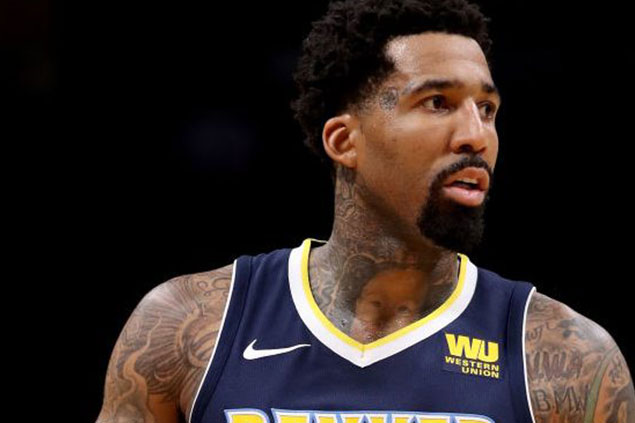LeBron James is going to L.A. Paul George is staying in Oklahoma City. With the Philadelphia 76ers’ two blockbuster free agent targets off the market, Kawhi Leonard is the only available star they’ve had their eyes on. And once the Sixers completed a trade with the Denver Nuggets to acquire Wilson Chandler, a 2021 second-round pick and the rights to swap a 2022 second-round pick, the instant reaction by many was that this was the precursor to a deal for Leonard.
It’s probably due to the disappointment of having no new big name in Philly; why settle for Chandler when you can star hunt? Given how badly Denver wanted to clear salary, some also may have hoped for a first-round pick in the trade as a prize for taking on Chandler’s $12.8 million contract and saving the Nuggets almost $40 million in luxury tax. (Although, seeing as Chandler is actually a decent player and his deal is expiring, letting the Sixers free up another chunk of cap space for the talent of free agency in 2019, getting second-rounders isn’t bad whatsoever.)
Chandler can be traded immediately, so it’s not surprising that a lot of focus shifted straight to Leonard. His salary can help in a deal and he can provide the Spurs with some extra wing depth after losing Leonard. Alternatively, if the Sixers trade Robert Covington for Leonard, Chandler gives that same wing assurance to the Sixers.
But that isn’t all Chandler is good for. With the Spurs in no hurry to make a trade, Chandler is in a position to contribute on the court, helping to address some of the wing issues that have bothered Philly.
The Sixers were thin on the wing after Covington last season. When left with limited, inexperienced players like Justin Anderson and Timothe Luwawu-Cabarrot, or the smaller, slow-footed Marco Belinelli, it was hard to keep up with the army of talented wings that a team like the Boston Celtics has. There’s little off-the-dribble play from most of Philly’s wings offensively, with a lack of size and competency on defense (sorry, Belinelli).
Chandler ticks a few boxes for what the Sixers need off the bench. He can provide a good 15-20 minutes per game, using enough shooting and superior play off the bounce to the team’s other wings to complement Ben Simmons and Joel Embiid.
With Denver adding All-Star Paul Millsap (at least for 38 games when he was healthy) last season to go along with the increased production of Gary Harris and Jamal Murray, Chandler wasn’t as important to the offense. After averaging a career-high 15.7 points per game in 2016-17 to go along with 6.5 rebounds, Chandler slipped to 10 points, 5.4 rebounds and 2.2 assists a night in 2017-18, but his skill set hasn’t diminished.
Despite only being an average to slightly below average 3-point shooter through his career, Chandler hit a reasonable 35.8 percent of his 3s last season (3.3 attempts) and made 38.3 percent of his catch-and-shoot attempts. He’ll be just fine spotting up in another talented offense with Simmons to set him up. And with some ability when driving, posting up, attacking off the bounce and beating closeouts (or switches onto bigs), Chandler is far more capable with the ball in his hands than the likes of Belinelli, Anderson and Luwawu-Cabarrot to provide a reliable scoring spark off the bench.
In a low-usage role where he doesn’t need to do anything special, Chandler should find it easy to make a positive impact.
Meanwhile, on defense, it’s the issue of small, unathletic wing play that hurt the Sixers most. The playoffs (particularly the Boston series) highlighted just how much JJ Redick and Belinelli could be attacked, either from the perimeter by faster wings or off switches through pick-and-rolls or post-ups by bigs like Al Horford. The two guards were often liabilities.
Now, the Sixers don’t need to worry about that as much. They can use a hyper explosive guard like Zhaire Smith with the 6’8”-or-more quartet of Simmons, Chandler, Covington and Embiid to bother opponents with switching and length across the board. Chandler is another mobile wing with good size and strong rebounding, who can operate as an extra option at power forward when need be. He played some sound defense when engaged last season, and is, at the very least, an immediate upgrade over Redick or Belinelli. Not to mention, moving from Denver’s bottom-four defense to being surrounded by Philly’s elite forwards and Defensive Player of the Year runner-up Embiid should only help Chandler, too.
Depending on how Markelle Fultz fares this season (I’m all in on him bouncing back in a big way), Chandler has a chance to be the Sixers’ best bench player immediately.
Sure, he’s not a star. It would be great if Chandler could help facilitate a Kawhi trade for the Sixers, either as a backup in Covington’s departure or as a piece to get the deal done.
In the meantime, though, with no guarantees or rushed Spurs decisions on the horizon, the Sixers can be happy with what they have in front of them: a wing who fits the team and strengthens the bench at both ends of the floor. And thanks to Chandler’s contract expiring after next season and no more bad, long-term money being taken on in free agency, the Sixers are still in perfect position to make a major move a year from now (Kawhi, Klay Thompson, Kevin Durant, Kyrie Irving and Jimmy Butler, if the latter two decline their player options, are all available).
The Sixers can continue their growth next season, developing a talented core that’s still years away from its prime, with the flexibility to add a star to bolster the process next summer. There’s nothing wrong with that.
All statistics courtesy of Basketball-Reference.com and NBA.com.
